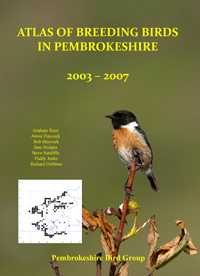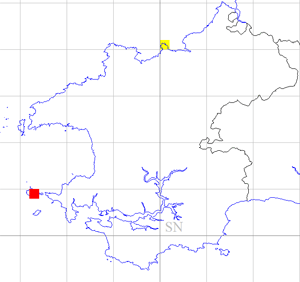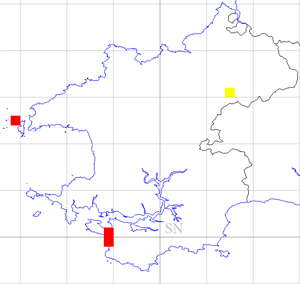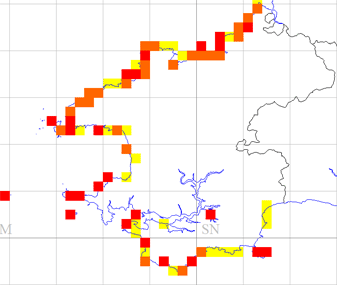Guillemot - 2003-07
 Wednesday, May 9, 2012 at 6:13PM
Wednesday, May 9, 2012 at 6:13PM Guillemots nest in dense, noisy colonies with many birds crowding together. Mainly nesting on ledges on near vertical cliffs, they are also present on the top of sea stacks in a few sites.
Guillemots are found in very large numbers on the south coast at Castlemartin, especially at Elegug Stacks, where the well known colonies provide a thrilling and easily observed wildlife spectacle. Skomer has the largest island colony, but there are quite significant colonies on St Margaret’s Island, on Skokholm, and on Ramsey. A small number breed on Grassholm and on the north coast of the county there are scattered colonies of a few hundred birds.
The overall population has been increasing steadily for 40 years and although there have been minor “blips” in the rate of increase this trend is echoed at all colonies. The main study colonies and the detailed whole island counts on Skomer, suggest an average annual rate of increase of 5.7%, the colony increasing from 2,400 birds in 1970 to 17,700 in 2008. In the period between the two atlases of 1984–88 and 2003-07, the overall county population grew from around 16,000 to over 30,000 birds.
The number of Guillemots is currently at its highest level since counting seabirds became a regular annual priority for conservationists and ornithologists, but there is some evidence from comments made by Lockley et al (1949) that pre war populations were higher, perhaps much higher, on the basis of some photographs of colonies. It was surmised that during the war years the high level of marine pollution caused the deaths of many thousands of Guillemots.
Guillemots are very vulnerable to marine pollution incidents as they spend most of their time "rafting" (floating on the surface) and shallow-diving. The Sea Empress incident at the entrance to Milford Haven in February 1996, followed by the Erika incident off the French coast in January 2000, killed many birds from the Pembrokeshire colonies. The Sea Empress spill killed mainly adults and there was a subsequent 60% decline in breeding numbers on St Margaret’s Island. The effects at other coastal and the major island colonies was less clear but subsequent research has shown that such incidents do manifest themselves in reduced survival rates in the years following the incident. However, because there are so many immature birds trying to establish themselves in the colonies the effect has been masked. (Votier et al 2005). The Erika incident mainly affected immature birds less than 6 years old and there was no discernable subsequent effect on numbers at any of the colonies.
Steve Sutcliffe

Fieldwork 2003-07 (based on 490 tetrads)
Red = breeding confirmed = 17
Yellow = breeding possible = not included
Total tetrads in which registered = 17 (3.5%
 PBBA 2003-7,
PBBA 2003-7,  SJS in
SJS in  Guillemot
Guillemot 










